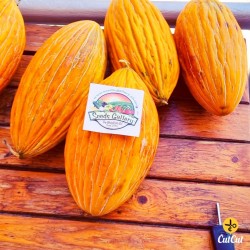Menu
-
MenuVissza
- Home
-
Kategóriák
-
-
Kategóriák
-
Zöldségmagok
-
Fajták országonként
- Fajták Örményország
- Fajták BiH
- Fajták Horvátországból
- Fajták Franciaországból
- Varieties from Germany
- Varieties from Greece
- Varieties from Hungary
- Fajták India
- Varieties from Italy
- Fajták Japánból
- Fajták Észak-Macedónia
- Varieties from Peru
- Varieties from Russia
- Varieties from Serbia
- Szlovéniából származó fajták
- Varieties from Spain
- Varieties from Thailand
- Fajták Törökország
- Varieties from USA
- Paradicsommag
- Kukoricamag
- Tök család magjai
- Babcsalád
- Uborka mag
- Paprikamag
- Sárgarépa család
- Hagyma család
- Saláta magok
- Burgonya család
- Káposzta család
- Retekmag
- Cékla család
- Görögdinnye magok
- Dinnye magok
- Karfiolmag
- Napraforgó család
-
Fajták országonként
- Gyümölcsmag
- Chili paprika magok
- Gyógynövénymagok
- Hegymászó növények magjai
- Fák - cserje - magok
- Pálma mag
- Díszes fűmagok
- Dohánymagok
-
Zöldségmagok
-
-
-
-
- ÚJ TERMÉKEK
- Fiók létrehozása
- Szállítás - fizetés
- FAQ
- Kezdőlap
-
- Nagy csomag magok
- Óriás növények magjai
- Zöldségmagok
- Fajták országonként
- Fajták Örményország
- Fajták BiH
- Fajták Horvátországból
- Fajták Franciaországból
- Varieties from Germany
- Varieties from Greece
- Varieties from Hungary
- Fajták India
- Varieties from Italy
- Fajták Japánból
- Fajták Észak-Macedónia
- Varieties from Peru
- Varieties from Russia
- Varieties from Serbia
- Szlovéniából származó fajták
- Varieties from Spain
- Varieties from Thailand
- Fajták Törökország
- Varieties from USA
- Paradicsommag
- Kukoricamag
- Tök család magjai
- Babcsalád
- Uborka mag
- Paprikamag
- Sárgarépa család
- Hagyma család
- Saláta magok
- Burgonya család
- Káposzta család
- Retekmag
- Cékla család
- Görögdinnye magok
- Dinnye magok
- Karfiolmag
- Napraforgó család
- Fajták országonként
- Gyümölcsmag
- Chili paprika magok
- Gyógynövénymagok
- Hegymászó növények magjai
- Fák - cserje - magok
- Banánmag
- Pálma mag
- Díszes fűmagok
- Dohánymagok
- Virágmag
- Kaktuszmag
- Vízinövények magjai
- Vetési utasítások
- Gyümölcs- és zöldségformák
- Gomba micélium
- Növényi gumókat
- Bambuszmag
- Ayurveda növények
- F1 hibrid magvak
- Csomagolás és ilyesmi
- Hidegen ellenálló növények
- Növények gondozása
- Organikus fűszerek
- Szállítás - fizetés
- Nincs PayPal és kártyás fizetés X
Last Product Reviews
Out of the two seeds, one germinated and the other one was dead and floatin...
By
 Riikka H on 07/03/2024
Riikka H on 07/03/2024
Verified Purchase
Népszerű termékek
1316 termék található.
406-420 / 1316 elem mutatása
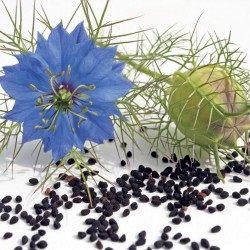
Black Caraway, Black Cumin...
Ár
2,15 €
(SKU: MHS 128)
Seeds Gallery EU,
5/
5
<h2><strong>Black Caraway, Black Cumin Seeds (Nigella sativa)</strong></h2>
<h2><span style="color: #ff0000;" class=""><strong>Price for Package of 500 (1.5g) seeds.</strong></span></h2>
<p><span style="font-size: 10pt;">You may or may not have heard of Black seed (nigella sativa) before. It goes by many names, including black caraway, Roman coriander, and black cumin, to name a few. But no matter what you call it, these seeds are loaded with health benefits that we are only beginning to understand. From eliminating harmful bacteria to regenerating the body’s cells and tissues, here are 10 awesome research-backed health benefits of black cumin.</span></p>
<p><span style="font-size: 10pt;">Nigella sativa (black seeds), an annual flowering plant that grows to 20-30cm tall, is native to Asia and the Middle East. The flowers of this plant are very delicate and pale colored and white. The seeds are used in Middle Eastern cooking, such as in their local breads. The seeds are also used by thousands for their natural healing abilities.</span></p>
<ul>
<li><span style="font-size: 10pt;"><strong>1. Type 2 diabetes – </strong>Researchers found that just two grams daily of black seed could result in reduced fasting blood sugar levels, along with decreased insulin resistance, and increased beta-cell function in the pancreas.</span></li>
<li><span style="font-size: 10pt;"><strong>2. Epilepsy – </strong> Published in <em>Medical Science Monitor</em><em>, </em>one study found black seed to be effective at reducing the frequency of seizures in children who resisted conventional treatment. Black seed indeed has anti-convulsive properties.</span></li>
<li><span style="font-size: 10pt;"><strong>3. Colon Cancer –</strong> In cell studies, black seed has been found to have anti-cancer properties, inhibiting the growth of colon cancer cells specifically. In one animal study, the seed was able to <strong>fight colon cancer in rats successfully with no observable side effects</strong>. The same obviously can’t be said for conventional cancer treatments.</span></li>
<li><span style="font-size: 10pt;"><strong>4. MRSA –</strong> The deadly and antibiotic-resistant bacterial infection known commonly as MRSA responded favorably to treatment with black seed in this study from the University of Health Sciences in Lahore, Pakistan.</span></li>
<li><span style="font-size: 10pt;"><strong>5. Protection Against Heart Attack Damage –</strong> An extract from black seed has been shown to possess heart-protective qualities, dampening damages associated with heart attacks and boosting overall heart health.</span></li>
</ul>
<p><span style="font-size: 10pt;"><strong>Read: Health Benefits of 60+ Foods</strong></span></p>
<ul>
<li><span style="font-size: 10pt;"><strong>6. Breast Cancer –</strong> A few studies have linked a thymoquinone extract from nigella sativa to reduced breast cancer tumor growth and increased apoptosis (cell death) in breast cancer cells.</span></li>
<li><span style="font-size: 10pt;"><strong>7. Brain Cancer –</strong> A study published in the online journal <em>PLoS One</em> indicates thymoquinone from black seed can induce cell death in glioblastoma cells. <strong>Glioblastoma is one of the most aggressive brain tumors of all.</strong></span></li>
<li><span style="font-size: 10pt;"><strong>8. Leukemia –</strong> As it’s been shown to do with other types of cancer, black seed compound thymoquinone has also been shown to induce apoptosis in leukemia cells.</span></li>
<li><span style="font-size: 10pt;"><strong>9. Brain Damage from Lead –</strong> A study published in <em>Experimental and Toxicologic Pathology </em> indicates black seed is able to dampen and reverse damage to the brain sparked by lead toxicity.</span></li>
<li><span style="font-size: 10pt;"><strong>10. Oral Cancer – </strong>Research indicates thymoquinone from nigella sativa is able to induce cell apoptosis in oral cancer cells.</span></li>
</ul>
<p><span style="font-size: 10pt;">These ten benefits of nigella sativa are truly only the tip of the iceberg. Mounting evidence indicates this seed is a powerful healer. <strong>Stay tuned for Part 2 of this article where we’ll add to the list of benefits. </strong></span></p>
<p><span style="font-size: 10pt;"><strong>Other Names:</strong></span></p>
<p><span style="font-size: 10pt;">Ajenuz, Aranuel, Baraka, Black Cumin, Black Caraway, Charnuska, Cheveux de Vénus, Cominho Negro, Comino Negro, Cumin Noir, Fennel Flower, Fitch, Graine de Nigelle, Graine Noire, Kalajaji, Kalajira, Kalonji, La Grainer Noire, Love in a Mist, Mugrela, Nielle, Nigella sativa, Nigelle de Crête, Nigelle Cultivée, Nutmeg Flower, Poivrette, Roman-Coriander, Schwarzkummel, Small Fennel, Toute Épice, Upakuncika.</span></p><script src="//cdn.public.n1ed.com/G3OMDFLT/widgets.js"></script>
MHS 128 (1,5g)

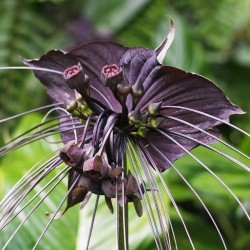
BLACK BAT FLOWER Seeds...
Ár
2,85 €
(SKU: F 66 B)
Seeds Gallery EU,
5/
5
<h2><span style="font-size:14pt;"><strong>BLACK BAT FLOWER Seeds (Tacca chantrieri)</strong></span></h2>
<h2><span style="color:#ff0000;font-size:14pt;"><strong>Price for Package of 4 seeds.</strong></span></h2>
<p>Tacca chantrieri, the black bat flower, is a species of flowering plant in the yam family Dioscoreaceae. Tacca chantrieri is an unusual plant in that it has black flowers. These flowers are somewhat bat-shaped, are up to 12 inches across, and have long 'whiskers' that can grow up to 28 inches. There are ten species in the genus Tacca. One of these, T. integrifolia, is commonly called the "white bat plant." T. integrifolia is similar to T. chantrieri, but has white bracts which are veined purple. T. integrifolia is larger than T. chantrieri, reaching up to four feet in height (almost twice the size of T. chantrieri at a height of 24"-36").</p>
<p>Tacca chantrierei is native to tropical regions of Southeast Asia including Thailand, Malaysia, and southern China: particularly Yunnan Province. They are understory plants, so they prefer shade (at least 60%). They grow best in well-drained soil with good air circulation, but they prefer high humidity, and need a lot of water. They are hardy to USDA zones 11, above 4.5 °C (40 °F).</p>
F 66 B


Oroszországból származó fajta
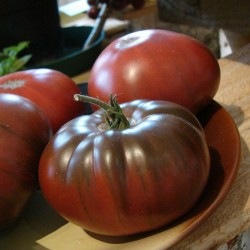
ARBUZNYI (watermelon) Big...
Ár
1,85 €
(SKU: VT 75)
Seeds Gallery EU,
5/
5
<h2 class=""><strong>ARBUZNYI (watermelon) Big Green Tomato Seeds</strong></h2>
<h2><span style="color: #ff0000;"><strong>Price for Package of 10 seeds.</strong></span></h2>
<p>Originally from Russia. Arbuznyi translates to "watermelon like" in Russian. Indeterminate, regular leaf, fruits are medium size, The colored fruits have occasional green striping, 4-8 oz, round oblate beefsteaks, beautiful skin color with dark green shoulders and faint thin dark green stripes. Outstanding unique flavor, smoky and slightly acidic, small seed cavities, juicy. Very productive and one of the highlights. Excellent taste (aka Watermelon Like).</p>
<p>75 days from transplant.</p><script src="//cdn.public.n1ed.com/G3OMDFLT/widgets.js"></script>
VT 75 (10 S)

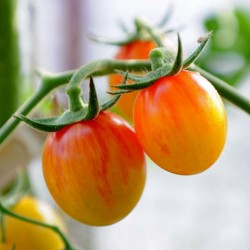
Artisan Golden Bumble Bee...
Ár
1,95 €
(SKU: VT 38)
Seeds Gallery EU,
5/
5
<h2><strong>Artisan Golden Bumble Bee Cherry Tomato Seeds</strong></h2>
<h2><span style="color:#ff0000;"><strong>Price for Package of 10 seeds.</strong></span></h2>
<p>ARTISAN™ Bumblebee is an exciting new series of open-pollinated 2-3cm (20-25 Gram) round cherry tomato varieties, which are best for greenhouse production or outdoor growing in warm, sunny and sheltered spots. Their distinctive stripes and stunning rich colors make them ideal for summer salads with a sweet flavor and resistance to cracking</p>
<p>Artisan Golden Bumble Bee is an indeterminate cherry tomato variety sure to create excitement with its extraordinary beauty and superb flavor The fruits are golden coloration with green stripes.</p>
<p>Sow in spring under glass or on a windowsill with warmth provided 1/16 inch deep. Germination takes around 6-14 days at 65-75F.</p>
<p>Transplant the seedlings when large enough to handle into 3-inch pots.</p>
<p>Grow on under cooler conditions and when about 8 inches tall, either plant in their growing position in the greenhouse or gradually acclimatise them to outdoor conditions and plant out 18 inches apart in a warm, sheltered and sunny spot in moist, fertile well-drained soil and keep watered.</p>
<p>What's the difference between "indeterminate" and "determinate" tomatoes?<br />Determinate tomatoes<br />or "bush" tomatoes, are varieties that grow to a compact height (generally 3 - 4'). Determinates stop growing when fruit sets on the top bud. All the tomatoes from the plant ripen at approximately the same time (usually over a period of 1- 2 weeks). They require a limited amount of staking for support and are perfectly suited for container planting.</p>
<p>Indeterminate tomatoes<br />will grow and produce fruit until killed by frost. They can reach heights of up to 12 feet although 6 feet is normal. Indeterminates will bloom, set new fruit and ripen fruit all at the same time throughout the season. They require substantial staking for support and benefit from being constrained to a central growing stem.</p>
VT 38 (10 S)


Peruból származó fajta
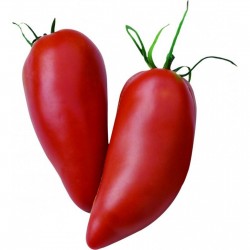
Andine Cornue Tomato Seeds
Ár
1,95 €
(SKU: VT 21)
Seeds Gallery EU,
5/
5
<!DOCTYPE html>
<html>
<head>
<meta http-equiv="Content-Type" content="text/html; charset=UTF-8" />
</head>
<body>
<h2><strong>Andine Cornue Tomato Seeds Rare Heirloom Organic Seeds</strong></h2>
<h2><span style="color: #ff0000;"><strong>Price for Package of 5 seeds.</strong></span></h2>
<p>The tomato Andine Cornue (in translation: Horn of the Andes) is one of the original tomato varieties from the Andes, introduced several years ago by a French collector. Traditional variety, very appreciated for its excellent organoleptic qualities, it is regarded as one of the best tomatoes. The average weight of the fruit is about 150-250 grams but can range up to 400 grams. The fruits are raspberry-colored and are very resistant to cracking, super-sweet and tasty fruit, with no acidity, with few seeds and excellent flavor. Fruits are ripening after 80 days. The plants reach the height from 120 to 180 centimeters, robust very productive.</p>
<p><strong>We do not use any pesticides or herbicides. We use only organic compost.</strong></p>
</body>
</html>
VT 21


Olasz fajta
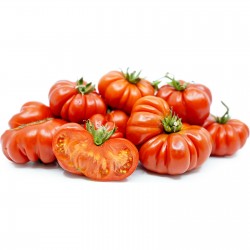
Costoluto Genovese Sic....
Ár
1,65 €
(SKU: VT 39)
Seeds Gallery EU,
5/
5
<h2 class=""><strong>Costoluto Genovese Sic. Heirloom Tomato Seeds</strong></h2>
<h2><span style="color: #ff0000;"><strong>Price for Package of 10 seeds.</strong></span></h2>
<p>The old Italian favorite that has been around since the early 19th century. Costoluto Genovese is a large (plant height up to 200 cm), juicy Italian tomato with an acidic-tart full-tomato flavor well suited for slicing and serving fresh or cooking. In Italy Costoluto Genovese is a favorite for pasta sauces and pastes</p>
<p>The fruit (weight 130-250 g) is rather flattened and quite attractive with their deep ribbing. This variety is a standard in Italy for both fresh eating and preserving, known for its intensely flavorful, deep red flesh.</p>
<p>Costoluto Genovese has been a Mediterranean favorite since at least the early eighteenth century. The key to this mid-season beefsteak’s rich tomato flavor is heat. Grown away from the dry, sun-drenched gardens of the Mediterranean this tomato might disappoint.</p><script src="//cdn.public.n1ed.com/G3OMDFLT/widgets.js"></script>
VT 39 (10 S)

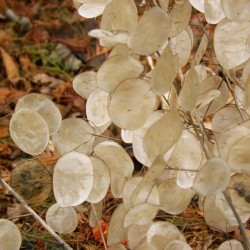
Honesty Silver Pennies...
Ár
2,50 €
(SKU: F 14)
Seeds Gallery EU,
5/
5
<!DOCTYPE html>
<html>
<head>
<meta http-equiv="Content-Type" content="text/html; charset=UTF-8" />
</head>
<body>
<h2><strong>Honesty Silver Pennies Seeds (Lunaria annua)</strong></h2>
<h2><span style="color: #ff0000;"><strong>Price for Package of 10 seeds.</strong></span></h2>
<div>Lunaria annua is an old fashioned dual purpose plant, grown partly for its fragrant bright flowers in spring and summer, but also for its unique seed-heads, oval and translucent, gleaming with an eerie silver light and coveted by dried-flower arrangers. <span style="line-height: 1.5em;">It is properly grown as a biennial, and makes large, well-branched plants in its second year. However, smaller plants can be grown as hardy annuals from an early sowing, with a smaller flower display, but very good compact seed-heads</span></div>
<div>Before the days of sophisticated dried flowers Honesty was particularly popular at Christmas and New Year and, after it had been arranged, would often stay in its vase for months. If it was home-grown it would be cut during a dry spell in September or October, then hung upside down in a dry place until needed. Nowadays most of us would prefer to leave the plants to decorate the garden. There is keener interest in the winter garden and the seed pods of honesty can look wonderful in an otherwise bleak garden.</div>
<div>Honesty blooms in rich, purples, pinks and starry bi-coloured combinations which are almost fluorescent at sunset. It is a vital nectar plant and therefore popular with bees and butterflies, very easy to grow, normally self-seeding itself in sunny or shady positions</div>
<div>Over a long season it produces masses of silvery pods. When dried, the green outer covering peels off to reveal the silvery translucent "silver pennies” or “dollars”.</div>
<div>Sowing: Sow direct in spring to late summer</div>
<div>Seeds can be sown in situ otherwise they can be simply sprinkled on loam-based seed compost, covered with grit and kept in a warm, light place.</div>
<div>Sowing Direct:</div>
<div>Sow thinly outdoors directly where they are to flower, in drills 3mm (1/8in) deep. 30cm (12in) apart. Keep the soil damp until germination takes place and if the seedlings become crowded, thin out to 15cm (6in) apart. Cover the seed lightly and water well.</div>
<div>Sowing Indoors:</div>
<div>Sow the large seeds one to a module compartment or in separate pots – where they can develop individually and be planted out without root disturbance. Use a loam-based seed compost, cover with grit and kept in a warm, light place. <span style="line-height: 1.5em;">Honesty develops thick storage roots, almost like tubers, and, in common with other brassicas, has deep tap roots. Keeping them in pots for any length of time prevents the roots developing properly and, if plants are not put out promptly, they will dwindle. </span><span style="line-height: 1.5em;">Prepare the planting hole with plenty of good home-made compost or leaf-mould. Plant out when all frosts have gone.</span></div>
<div>Cultivation:</div>
<div>Lunaria annua needs no pampering; it will cope in most situations and seems happiest growing among other plants. Grow in fertile, moist but well-drained soil. It prefers partial shade but will tolerate full sun. In common with most brassicas it prefers lime and resents peat or very acidic conditions. Avoid overfeeding and do not use manure.</div>
<div>Dried Flowers:</div>
<div>The key to getting good “silver pennies” is to make sure that the seed pods are perfectly dry. Cut the stems bearing seed pods and hang in bunches upside down in a cool airy room to dry. Once dry, gently remove the outer seed casing before using them for floral decoration.</div>
<div>Collecting Seed</div>
<div>Spread out the flower heads on a piece of drawing paper when they are dry and crisp. Each disc is composed of twin circular plates locked together and enclosing three large flat seeds. These are also disc-shaped <span style="line-height: 1.5em;">At the top of each case is a tiny protuberance that you pull like a ring-pull on a can to peel off one layer. The three seeds stick to this thin skin, leaving the backing-sheet clean and translucently silver, still attached to the stalk.</span></div>
<div>Plant Uses:</div>
<div>Cottage/Informal Garden, Flower Arranging, Flowers Borders and Beds. Butterfly and Wildflower Gardens. <span style="line-height: 1.5em;">Origin: </span><span style="line-height: 1.5em;">although not a true native of the British Isles. Lunaria annua is originally of European origin, Lunaria annua is common in gardens and it is often found naturalised as a garden escapee.</span></div>
<div>Nomenclature <span style="line-height: 1.5em;">The genus name Lunaria is derived from the Latin "lun (a)" meaning "moon" pertaining to the big round fruits of the plant. The species name annua is from the Latin "annu" meaning "year". The plant is typically biennial, however. </span><span style="line-height: 1.5em;">A member of the Brassicaceae or Cruciferae, also known as the crucifers, the mustard family or cabbage family is a family of flowering plants. Cruciferae is an older name, meaning "cross-bearing", because the four petals of their flowers are reminiscent of a cross.</span></div>
<div>Flowers: Lilac / Pink in April to July</div>
<div>Height: 60-90cm (24-36)</div>
<div>Spacing: 38-45cm (15-18in)</div>
<div>
<p>Position: Full Sun to Partial Shade</p>
</div>
</body>
</html>
F 14

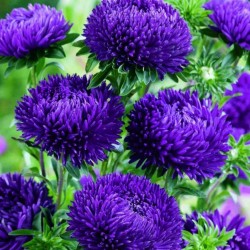
Chinese Aster Blue
Ár
1,95 €
(SKU: F 22)
Seeds Gallery EU,
5/
5
<div id="idTab1" class="rte">
<h2><span style="font-size:14pt;"><strong>Chinese Aster Blue (Callistephus Aster)</strong></span></h2>
<h3><span style="font-size:14pt;"><strong><span style="color:#ff0000;">Price for Package of 260 seeds (0,5g).</span></strong></span></h3>
<div><span style="line-height:1.5em;">Gremlin is a tall double variety of aster which makes excellent, long lasting cut flowers grown from flower seeds. Sow these flower seeds in well-drained soil in a sunny spot. This dark violet aster has twisted petals which are said to resemble a "tiger's paw" and is often referred to as Tiger Paw Aster or Krallenaster. The Gremlin aster is an extremely late cut flower with huge flowers with curved and quilled petals. This aster, when grown from flower seed, has an upright growth habit reaching nearly 30 inches in height.</span></div>
<div>Sowing:</div>
<div>Sow indoors 6 to 8 weeks before the last frost date, or sow directly where they are to flower once the soil has warmed. For a continuous show, you may wish to plant stagger the sowing dates. The seed may also be direct sown in April to May where the plants are to flower, but in this case flowering will start later. A sunny situation should be chosen for the aster bed, which should be prepared as soon as possible, making sure that drainage is good.</div>
<div>Sowing Indoors March to April</div>
<div>March and April sowing should be made in gentle heat, sowing into trays of compost, “Just cover” the seeds with a sprinkling of compost or vermiculite.</div>
<div>When large enough to handle, transplant seedlings into 7.5cm (3in) pots or trays. Handle the plants with care and avoid disturbing the roots as much as possible when transplanting to prevent wilting.</div>
<div>Gradually hardened off for 10 to 14 days before transplanting into the flowering site in early May. Light spring frosts will not harm the plants.</div>
<div>Plant 25 -40cm (10 to 16in) apart.</div>
<div>Direct Sowing April to May</div>
<div>Sow thinly, 6mm (1/4in) deep in small clumps or shallow drills. Sow 30cm (12in) apart in well-cultivated soil which has been raked to a fine tilth. Water ground regularly, especially in dry periods.</div>
<div>When large enough to handle, thin out seedlings until they are finally 30cm (12in) apart in spring</div>
<div>Outside sowings should be gradually thinned to the same spacings when the seedlings are large enough to handle.</div>
<div>Cultivation:</div>
<div>Flowers should be removed as soon as they have faded to promote the growth of further blooms. Never over water, but do not let the soil dry out.</div>
<div>Preventive measures should be taken against aphids.</div>
<div>Cut flowers will last 8 to 10 days in water. Cut when flowers are half-open; recut stems underwater.</div>
<div>Plant Uses: </div>
<div>Cut Flowers, Flowers Borders and Beds, Patio and Container Plants</div>
<div>Note:</div>
<div>Plants must not be planted in the same ground two years in a row to avoid Fusarium Wilt - a soil-borne disease that has plagued Asters in the past.</div>
<div>Nomenclature:</div>
<div>The name Aster comes from the Ancient Greek word astron, meaning "star", arriving through the Latin word astrum with the same meaning, referring to the shape of the flower head.</div>
<div>The genus name Callistephus (pronounced ka-LIS-te-fus) is derived from the Greek words “kallos” (meaning beautiful) and “stephanus” (meaning crown).</div>
</div>
F 22


Staghorn sumac seeds (Rhus...
Ár
1,75 €
(SKU: T 20)
Seeds Gallery EU,
5/
5
<h2><strong>Staghorn sumac seeds (Rhus typhina)</strong></h2>
<h2><span style="color:#ff0000;"><strong>Price for Package of 20 seeds.</strong></span></h2>
<p>Very Fast Growth, Tropical Looking Flowering Tree, Extremely Hardy, Bonsai, Specimen Tree, Medicinal, Cold, Drought, Urban, and Salt Tolerant...</p>
<p><i><b>Rhus typhina</b></i><span>, the </span><b>staghorn sumac</b><span>,</span><sup id="cite_ref-1" class="reference"></sup><span> is a </span>species<span> of </span>flowering plant<span> in the </span>family<span> Anacardiaceae, </span>native<span> to eastern North America. It is primarily found in southeastern Canada, the northeastern and midwestern United States and the Appalachian Mountains,</span><sup id="cite_ref-2" class="reference"></sup><span> but is widely cultivated as an ornamental throughout the </span>temperate<span> world.</span></p>
<p><i>Rhus typhina</i><span> </span>is a<span> </span>dioecious,<span> </span>deciduous<span> </span>shrub<span> </span>or small<span> </span>tree<span> </span>growing up to 5 m (16 ft) tall by 6 m (20 ft) broad. It has alternate, pinnately compound leaves 25–55 cm (10–22 in) long, each with 9–31 serrate leaflets 6–11 cm (<span class="frac nowrap">2<span class="visualhide"> </span><sup>1</sup>⁄<sub>4</sub></span>–<span class="frac nowrap">4<span class="visualhide"> </span><sup>1</sup>⁄<sub>4</sub></span> in) long.<sup id="cite_ref-Uva_4-0" class="reference">[4]</sup><span> </span>Leaf petioles and stems are densely covered in rust-colored hairs. The velvety texture and the forking pattern of the branches, reminiscent of<span> </span>antlers, have led to the common name "stag's horn sumac".<sup id="cite_ref-RHSAZ_5-0" class="reference">[5]</sup><span> </span>Staghorn sumac grows as female or male clones.<sup id="cite_ref-6" class="reference">[6]</sup></p>
<p>Small, greenish-white through yellowish flowers occur in dense terminal panicles, and small, green through reddish<span> </span>drupes<span> </span>occur in dense infructescences.<span> </span><sup id="cite_ref-Uva_4-1" class="reference">[4]</sup><span> </span>Flowers occur from May through July and fruit ripens from June through September in this species’ native range.<sup id="cite_ref-7" class="reference">[7]</sup><span> </span>Infructescences are 10–20 cm (4–8 in) long and 4–6 cm (<span class="frac nowrap">1<span class="visualhide"> </span><sup>1</sup>⁄<sub>2</sub></span>–<span class="frac nowrap">2<span class="visualhide"> </span><sup>1</sup>⁄<sub>4</sub></span> in) broad at their bases. Fall foliage is brilliant shades of red, orange and yellow.<sup id="cite_ref-RHSAZ_5-1" class="reference">[5]</sup><span> </span>Fruit can remain on plants from late summer through spring.</p>
<p>Staghorn sumac spreads by seeds and<span> </span>rhizomes<span> </span>and forms clones often with the older shoots in the center and younger shoots around central older ones.<sup id="cite_ref-Uva_4-2" class="reference">[4]</sup><span> </span>Large clones can grow from<span> </span><span class="cleanup-needed-content">octets</span><sup class="noprint Inline-Template">[<i><span title="What is the meaning of “octets”? (October 2018)">clarification needed</span></i>]</sup><span> </span>in several years.</p>
<p>Within Anacardiaceae, staghorn sumac is not closely related to<span> </span>poison sumac<span> </span>(<i>Toxicodendron vernix</i>), although they share the name "sumac."</p>
<p>In late summer some shoots have galls on leaf undersides, caused by the sumac leaf gall aphid,<span> </span><i>Melaphis rhois</i>. The galls are not markedly harmful to the tree.</p>
<h2><span class="mw-headline" id="Cultivation">Cultivation</span></h2>
<p>Staghorn sumac is an ornamental plant which provides interest throughout the year; though its vigorous, suckering habit makes it unsuitable for smaller gardens. It can grow under a wide array of conditions, but is most often found in dry and poor soil on which other plants cannot survive.<sup id="cite_ref-Uva_4-3" class="reference">[4]</sup><span> </span>Some landscapers remove all but the top branches to create a "crown" effect in order to resemble a small palm tree. Numerous<span> </span>cultivars<span> </span>have been developed for garden use, of which 'Dissecta'<span> </span>syn.<span> </span>'Laciniata' (<b>cutleaf staghorn sumac</b>) has gained the<span> </span>Royal Horticultural Society’s<span> </span>Award of Garden Merit.<sup id="cite_ref-RHSPF_8-0" class="reference">[8]</sup><sup id="cite_ref-9" class="reference">[9]</sup></p>
<p>In both French and German, the common name of the species (sumac vinaigrier, Essigbaum) means "vinegar tree".</p>
<h2><span class="mw-headline" id="Other_uses">Other uses</span></h2>
<p>Some beekeepers use dried sumac bobs as a source of fuel for their smokers.</p>
<p>The fruit of sumacs can be collected, soaked and washed in cold water, strained, sweetened and made into a pink "lemonade" sometimes called "Indian lemonade".<sup id="cite_ref-10" class="reference">[10]</sup><span> </span>The leaves and berries of staghorn sumac have been mixed with<span> </span>tobacco<span> </span>and other herbs and smoked by<span> </span>Native American<span> </span>tribes.<sup id="cite_ref-11" class="reference">[11]</sup><span> </span>This practice continues to a small degree to this day.</p>
<p>All parts of the staghorn sumac, except the roots, can be used as both a<span> </span>natural dye<span> </span>and as a<span> </span>mordant. The plant is rich in<span> </span>tannins<span> </span>and can be added to other dye baths to improve light<span> </span>fastness. The leaves may be harvested in the summer and the bark all year round.</p>
<table cellspacing="0" cellpadding="0" border="1"><tbody><tr><td colspan="2" width="100%" valign="top">
<p><span style="color:#008000;"><strong>Sowing Instructions</strong></span></p>
</td>
</tr><tr><td valign="top" nowrap="nowrap">
<p><span style="color:#008000;"><strong>Propagation:</strong></span></p>
</td>
<td valign="top">
<p><span style="color:#008000;">Seeds</span></p>
</td>
</tr><tr><td valign="top" nowrap="nowrap">
<p><span style="color:#008000;"><strong>Pretreat:</strong></span></p>
</td>
<td valign="top">
<p><span style="color:#008000;">soak in water for 24 hours</span></p>
</td>
</tr><tr><td valign="top" nowrap="nowrap">
<p><span style="color:#008000;"><strong>Stratification:</strong></span></p>
</td>
<td valign="top">
<p><span style="color:#008000;">4-6 Weeks in moist sowing mix at 2-5 ° C refrigerator</span></p>
</td>
</tr><tr><td valign="top" nowrap="nowrap">
<p><span style="color:#008000;"><strong>Sowing Time:</strong></span></p>
</td>
<td valign="top">
<p><span style="color:#008000;">all year round</span></p>
</td>
</tr><tr><td valign="top" nowrap="nowrap">
<p><span style="color:#008000;"><strong>Sowing Depth:</strong></span></p>
</td>
<td valign="top">
<p><span style="color:#008000;">6,3 mm - 1/4"</span></p>
</td>
</tr><tr><td valign="top" nowrap="nowrap">
<p><span style="color:#008000;"><strong>Sowing Mix:</strong></span></p>
</td>
<td valign="top">
<p><span style="color:#008000;">Coir or sowing mix + sand or perlite</span></p>
</td>
</tr><tr><td valign="top" nowrap="nowrap">
<p><span style="color:#008000;"><strong>Germination temperature:</strong></span></p>
</td>
<td valign="top">
<p><span style="color:#008000;">15-20 ° C</span></p>
</td>
</tr><tr><td valign="top" nowrap="nowrap">
<p><span style="color:#008000;"><strong>Location:</strong></span></p>
</td>
<td valign="top">
<p><span style="color:#008000;">bright + keep constantly moist not wet</span></p>
</td>
</tr><tr><td valign="top" nowrap="nowrap">
<p><span style="color:#008000;"><strong>Germination Time:</strong></span></p>
</td>
<td valign="top">
<p><span style="color:#008000;">until it germinates </span></p>
</td>
</tr><tr><td valign="top" nowrap="nowrap">
<p><span style="color:#008000;"><strong>Watering:</strong></span></p>
</td>
<td valign="top">
<p><span style="color:#008000;">Water regularly during the growing season</span></p>
</td>
</tr><tr><td valign="top" nowrap="nowrap">
<p><span style="color:#008000;"><strong> </strong></span></p>
</td>
<td valign="top">
<p><br /><span style="color:#008000;"><em>Copyright © 2012 Seeds Gallery - Saatgut Galerie - Galerija semena. </em><em>All Rights Reserved.</em></span></p>
</td>
</tr></tbody></table>
T 20


A növény ellenáll a hidegnek és a fagynak
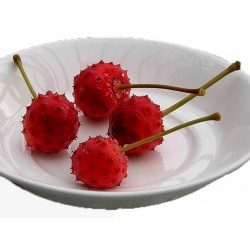
Kousa dogwood Seeds (Cornus...
Ár
1,95 €
(SKU: V 77)
Seeds Gallery EU,
5/
5
<meta http-equiv="Content-Type" content="text/html; charset=UTF-8" />
<h2><strong>Kousa dogwood Seeds (Cornus kousa) Edible Fruits</strong></h2>
<h2><span style="color: #ff0000;"><strong>Price for Package of 5 seeds.</strong></span></h2>
<p>The Kousa dogwood (Cornus kousa or Benthamidia kousa) is a small deciduous tree 8–12 m (26–39 ft) tall, native to eastern Asia. Like most dogwoods, it has opposite, simple leaves, 4–10 cm long. The tree is extremely showy when in bloom, but what appear to be four-petalled white flowers are actually bracts spread open below the cluster of inconspicuous yellow-green flowers. The blossoms appear in late spring, weeks after the tree leafs out. The Kousa dogwood is sometimes also called "Chinese dogwood", Korean Dogwood, or Japanese dogwood.</p>
<p><strong>Characteristics</strong></p>
<p>The kousa dogwood can be distinguished from the closely related flowering dogwood (Cornus florida) of eastern North America by its more upright habit, flowering about a month later, and having pointed rather than rounded flower bracts.</p>
<p>The fruit is a globose pink to red compound berry 2–3 cm in diameter, though these berries tend to grow larger towards the end of the season and some berry clusters that do not fall from the tree surpass 4 cm. <strong>It is edible, a sweet and delicious</strong> addition to the tree's ornamental value. <strong>The fruit is sometimes used for making wine.</strong></p>
<p>It is resistant to the dogwood anthracnose disease, caused by the fungus Discula destructiva, unlike C. florida, which is very susceptible and commonly killed by it; for this reason, C. kousa is being widely planted as an ornamental tree in areas affected by the disease. A number of hybrids between C. kousa and C. florida have also been selected for their disease resistance and good flower appearance.</p>
<p>Fall foliage is a showy red color.</p>
<table cellspacing="0" cellpadding="0" border="1">
<tbody>
<tr>
<td colspan="2" width="100%" valign="top">
<p><span style="color: #008000;"><strong>Sowing Instructions</strong></span></p>
</td>
</tr>
<tr>
<td valign="top" nowrap="nowrap">
<p><span style="color: #008000;"><strong>Propagation:</strong></span></p>
</td>
<td valign="top">
<p><span style="color: #008000;">Seeds</span></p>
</td>
</tr>
<tr>
<td valign="top" nowrap="nowrap">
<p><span style="color: #008000;"><strong>Pretreat:</strong></span></p>
</td>
<td valign="top">
<p><span style="color: #008000;">soak in water for 24 hours</span></p>
</td>
</tr>
<tr>
<td valign="top" nowrap="nowrap">
<p><span style="color: #008000;"><strong>Stratification:</strong></span></p>
</td>
<td valign="top">
<p><span style="color: #008000;">about 3-4 months in a moist substrate at 2-5 ° C in a refrigerator or cold house</span></p>
</td>
</tr>
<tr>
<td valign="top" nowrap="nowrap">
<p><span style="color: #008000;"><strong>Sowing Time:</strong></span></p>
</td>
<td valign="top">
<p><span style="color: #008000;">all year round </span></p>
</td>
</tr>
<tr>
<td valign="top" nowrap="nowrap">
<p><span style="color: #008000;"><strong>Sowing Depth:</strong></span></p>
</td>
<td valign="top">
<p><span style="color: #008000;">cover only slightly with substrate 0,5 cm</span></p>
</td>
</tr>
<tr>
<td valign="top" nowrap="nowrap">
<p><span style="color: #008000;"><strong>Sowing Mix:</strong></span></p>
</td>
<td valign="top">
<p><span style="color: #008000;">Coir or sowing mix + sand or perlite</span></p>
</td>
</tr>
<tr>
<td valign="top" nowrap="nowrap">
<p><span style="color: #008000;"><strong>Germination temperature:</strong></span></p>
</td>
<td valign="top">
<p><span style="color: #008000;">15-20 ° C +</span></p>
</td>
</tr>
<tr>
<td valign="top" nowrap="nowrap">
<p><span style="color: #008000;"><strong>Location:</strong></span></p>
</td>
<td valign="top">
<p><span style="color: #008000;">bright + keep constantly moist not wet</span></p>
</td>
</tr>
<tr>
<td valign="top" nowrap="nowrap">
<p><span style="color: #008000;"><strong>Germination Time:</strong></span></p>
</td>
<td valign="top">
<p><span style="color: #008000;">2-6 weeks</span></p>
</td>
</tr>
<tr>
<td valign="top" nowrap="nowrap">
<p><span style="color: #008000;"><strong>Watering:</strong></span></p>
</td>
<td valign="top">
<p><span style="color: #008000;"> in the growing season richly water</span></p>
</td>
</tr>
<tr>
<td valign="top" nowrap="nowrap"> </td>
<td valign="top">
<p><br /><span style="color: #008000;"><em>Copyright © 2012 Seeds Gallery - Saatgut Galerie - Galerija semena. </em><em>All Rights Reserved.</em></span></p>
</td>
</tr>
</tbody>
</table>
V 77 (5 S)


Ez a termék PayPal-lal vagy kártyával nem fizethető

Shirley Poppy Seeds Mixed...
Ár
1,95 €
(SKU: MHS 43)
Seeds Gallery EU,
5/
5
<div id="idTab1" class="rte">
<h2><strong>Shirley Poppy Seeds Mixed Colors, Decorative, Ornamental</strong></h2>
<h2><span style="color: #ff0202;"><strong>Price for a Package of 200 seeds.</strong></span></h2>
<p>Shirley Poppy (Papaver Rhoeas) - The Shirley Poppy comes from Shirley, England, where in the 1880s, a local vicar carefully selected and hybridized Poppies in his own wild flower garden. Over many years he obtained a strain of Poppies ranging in colors from white to pale lilac to pink and red, and unlike the wild Poppies these had no dark blotches at the base of the petals. Over the years, further wildflower Poppy selection has created the semi-double and double forms, as well as flowers with a ring of contrasting color around the edge called the picotee form. Easily grown from Shirley Poppy seeds, gardeners enthusiastically grow this variety for the wonderful display of diverse color and forms. How to Grow Poppies: Directly sow Poppy seeds in early spring before frosts have finished. Shirley Poppies grow best in loose soil that drains well. Press the flower seeds firmly into the soil and keep the soil moist until germination.<br /><br />Flower Specifications<br /><br /> Season: Annual<br /> USDA Zones: 3 - 9<br /> Height: 12 - 15 inches<br /> Bloom Season: Summer<br /> Bloom Color: Mix<br /> Environment: Full sun<br /> Soil Type: Loose, well-drained, pH 6.1 - 7.3<br /> Deer Resistant: Yes<br /><br />Planting Directions<br /><br /> Temperature: 55 - 60F<br /> Average Germ Time: 21 - 28 days<br /> Light Required: Yes<br /> Depth: Do not cover the seed but press into the soil<br /> Moisture: Keep seeds moist until germination<br /> Plant Spacing: 12 inches</p>
</div>
MHS 43 (200 S)

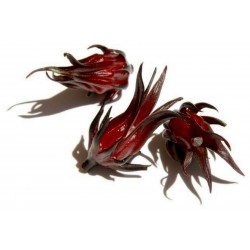
Roselle Seeds - Edible and...
Ár
2,75 €
(SKU: MHS 19)
Seeds Gallery EU,
5/
5
<div>
<h2><strong>Roselle Seeds - edible and tasty (Hibiscus sabdariffa)</strong></h2>
<h2><span style="color:#ff0000;"><strong>Price for Package of 10 seeds.</strong></span></h2>
<p>The roselle (Hibiscus sabdariffa) is a species of Hibiscus native to the Old World tropics, used for the production of bast fibre and as an infusion. It is an annual or perennial herb or woody-based subshrub, growing to 2–2.5 m (7–8 ft) tall. The leaves are deeply three- to five-lobed, 8–15 cm (3–6 in) long, arranged alternately on the stems.</p>
</div>
<p>The flowers are 8–10 cm (3–4 in) in diameter, white to pale yellow with a dark red spot at the base of each petal, and have a stout fleshy calyx at the base, 1–2 cm (0.39–0.79 in) wide, enlarging to 3–3.5 cm (1.2–1.4 in), fleshy and bright red as the fruit matures. It takes about six months to mature.</p>
<p><span><strong>Names</strong></span></p>
<p><span>The roselle is known as the rosella or rosella fruit in Australia. It is also known as 'Belchanda' among Nepalese, Tengamora among Assamese and "mwitha" among Bodo tribals in Assam, চুকর Chukor in Bengali, Gongura in Telugu, Pundi in Kannada, Ambadi in Marathi, LalChatni or Kutrum in Mithila] Mathipuli in Kerala, chin baung in Burma, กระเจี๊ยบแดง KraJiabDaeng in Thailand, ສົ້ມ ພໍດີ som phor dee in Lao PDR, bissap in Senegal, Guinea Bissau, Mali, Burkina Faso, Ghana, Benin and Niger, the Congo and France, dah or dah bleni in other parts of Mali, wonjo in the Gambia, zobo in western Nigeria (the Yorubas in Nigeria call the white variety Isapa (pronounced Ishapa)), Zoborodo in Northern Nigeria, Chaye-Torosh in Iran, karkade (كركديه; Arabic pronunciation: [ˈkarkade])[dubious – discuss] in Egypt, Saudi Arabia, and Sudan, omutete in Namibia, sorrel in the Caribbean and in Latin America, Flor de Jamaica in Mexico, Saril in Panama, grosella in Paraguay and vinagreira, caruru-azedo or quiabo-roxo in Brazil. Rosela in Indonesia, asam belanda[1] in Malaysia. In Chinese it is 洛神花 (Luo Shen Hua) . In Zambia the plant is called lumanda in ciBemba, katolo in kiKaonde, or wusi in chiLunda.</span></p>
<p><span><strong>Uses</strong></span></p>
<p><span>The plant is considered to have antihypertensive properties. In some places, the plant is primarily cultivated for the production of bast fibre from the stem of the plant. The fibre may be used as a substitute for jute in making burlap.[2] Hibiscus, specifically Roselle, has been used in folk medicine as a diuretic, mild laxative, and treatment for cardiac and nerve diseases and cancer.[3]</span></p>
<p><span>The red calyces of the plant are increasingly exported to America and Europe, where they are used as food colourings. Germany is the main importer. It can also be found in markets (as flowers or syrup) in some places such as France, where there are Senegalese immigrant communities. The green leaves are used like a spicy version of spinach. They give flavour to the Senegalese fish and rice dish thiéboudieune. Proper records are not kept, but the Senegalese government estimates national production and consumption at 700 t (770 short tons) per year. Also in Burma their green leaves are the main ingredient in making chin baung kyaw curry.</span></p>
<p><span>In East Africa, the calyx infusion, called "Sudan tea", is taken to relieve coughs. Roselle juice, with salt, pepper, asafoetida and molasses, is taken as a remedy for biliousness.</span></p>
<p><span>The heated leaves are applied to cracks in the feet and on boils and ulcers to speed maturation. A lotion made from leaves is used on sores and wounds. The seeds are said to be diuretic and tonic in action and the brownish-yellow seed oil is claimed to heal sores on camels. In India, a decoction of the seeds is given to relieve dysuria, strangury and mild cases of dyspepsia. Brazilians attribute stomachic, emollient and resolutive properties to the bitter roots.[4]</span></p>
<p><span><strong>Leafy vegetable/Greens</strong></span></p>
<p><span>In Andhra cuisine, Hibiscus cannabinus, called Gongura, is extensively used. The leaves are steamed along with lentils and cooked with Dal. The other unique dish prepared is gongura pachadi, it is prepared by mixing fried leaves with spices and made into a Gongura Pacchadi, the most famous dish of Andhra cuisine and is often described as king of all foods of Andhra ethnics(andhrulu)</span></p>
<p><span>In Burmese cuisine, called chin baung ywet (lit. sour leaf), the roselle is widely used and considered an affordable vegetable for the population. It is perhaps the most widely eaten and popular vegetable in Burma.[5] The leaves are fried with garlic, dried or fresh prawns and green chili or cooked with fish. A light soup made from roselle leaves and dried prawn stock is also a popular dish.</span></p>
<p><span><strong>Beverage</strong></span></p>
<p><span>Cuisine: Among the Bodo tribals of Bodoland, Assam (India) the leaves of both hibiscus sabdariffa and hibiscus cannabinus are cooked along with chicken, fish or pork, one of their traditional cuisines</span></p>
<p><span>In the Caribbean sorrel drink is made from sepals of the roselle. In Malaysia, roselle calyces are harvested fresh to produce pro-health drink due to high contents of vitamin C and anthocyanins. In Mexico, 'agua de Flor de Jamaica' (water flavored with roselle) frequently called "agua de Jamaica" is most often homemade. Also, since many untrained consumers mistake the calyces of the plant to be dried flowers, it is widely, but erroneously, believed that the drink is made from the flowers of the non-existent "Jamaica plant". It is prepared by boiling dried sepals and calyces of the Sorrel/Flower of Jamaica plant in water for 8 to 10 minutes (or until the water turns red), then adding sugar. It is often served chilled. This is also done in Saint Kitts and Nevis, Guyana, Antigua, Barbados, St. Lucia, Dominica, Grenada, Jamaica and Trinidad and Tobago where it is called 'sorrel'. The drink is one of several inexpensive beverages (aguas frescas) commonly consumed in Mexico and Central America, and they are typically made from fresh fruits, juices or extracts. A similar thing is done in Jamaica but additional flavor is added by brewing the tea with ginger and adding rum. It is a popular drink of the country at Christmas time. It is also very popular in Trinidad & Tobago but cinnamon, cloves and bay leaves are preferred to ginger. In Mali, Senegal, The Gambia, Burkina Faso and Benin calyces are used to prepare cold, sweet drinks popular in social events, often mixed with mint leaves, dissolved menthol candy, and/or various fruit flavors. The Middle Eastern and Sudanese drink "Karkade"(كركديه) is a cold drink made by soaking the dried Karkade flowers in cold water over night in a refrigerator with sugar and some lemon or lime juice added.It is then consumed with or without ice cubes after the flowers have been strained.In Lebanon, sometimes toasted pine nuts are tossed into the drink.</span></p>
<p><span>With the advent in the U.S. of interest in south-of-the-border cuisine, the calyces are sold in bags usually labeled "Flor de Jamaica" and have long been available in health food stores in the U.S. for making a tea that is high in vitamin C. This drink is particularly good for people who have a tendency, temporary or otherwise, toward water retention: it is a mild diuretic.</span></p>
<p><span>In addition to being a popular homemade drink, Jarritos, a popular brand of Mexican soft drinks, makes a Flor de Jamaica flavored carbonated beverage. Imported Jarritos can be readily found in the U.S.</span></p>
<p><span>In the UK the dried calyces and ready-made sorrel syrup are widely and cheaply available in Caribbean and Asian grocers. The fresh calyces are imported mainly during December and January in order to make Christmas and New Year infusions, which are often made into cocktails with additional rum. They are very perishable, rapidly developing fungal rot, and need to be used soon after purchase – unlike the dried product, which has a long shelf-life.</span></p>
<p><span>In Africa, especially the Sahel, roselle is commonly used to make a sugary herbal tea that is commonly sold on the street. The dried flowers can be found in every market. Roselle tea is also quite common in Italy where it spread during the first decades of the 20th century as a typical product of the Italian colonies. The Carib Brewery Trinidad Limited, a Trinidad and Tobago brewery, produces a Shandy Sorrel in which the tea is combined with beer.</span></p>
<p><span>In Thailand, Roselle is generally drunk as a cool drink,[6] but also as a tea, believed to also reduce cholesterol. It can also be made into a wine.</span></p>
<p><span>Hibiscus flowers are commonly found in commercial herbal teas, especially teas advertised as berry-flavoured, as they give a bright red colouring to the drink.</span></p>
<p><span>Rosella flowers are sold as Wild Hibiscus flowers in syrup in Australia as a gourmet product. Recipes include filling them with goats cheese, serving them on baguette slices baked with brie, & placing one plus a little syrup, in a champagne flute before adding the champagne when the bubbles cause the flower to open.</span></p>
<p><span><strong>Jam and preserves</strong></span></p>
<p><span>In Nigeria, rosella jam has been made since Colonial times and is still sold regularly at community fetes and charity stalls. It is similar in flavour to plum jam, although more acidic. It differs from other jams in that the pectin is obtained from boiling the interior buds of the rosella flowers. It is thus possible to make rosella jam with nothing but rosella buds and sugar. Roselle is also used in Nigeria to make a refreshing drink known as Zobo.</span></p>
<p><span>In Burma, the buds of the roselle are made into 'preserved fruits' or jams. Depending on the method and the preference, the seeds are either removed or included. The jams, made from roselle buds and sugar, are red and tangy.</span></p>
<p><span>"Sorrel jelly" is manufactured in Trinidad.</span></p>
<p><span>Rosella Jam is also made in Queensland, Australia as a home-made or speciality product sold at fetes and other community events.[7]</span></p>
<p><span><strong>Medicinal uses</strong></span></p>
<p><span>Many parts of the plant are also claimed to have various medicinal values. They have been used for such purposes ranging from Mexico through Africa and India to Thailand. Roselle is associated with traditional medicine and is reported to be used as treatment for several diseases such as hypertension and urinary tract infections.[8]</span></p>
<p><span>Although Roselle has well documented hypotensive effects,[9] there is currently insufficient evidence to support the benefit of Roselle for either controlling or lowering blood pressure due to a lack of well designed studies that measure the efficacy of Roselle on patients with hypertension.[10]</span></p>
<p><span>A double blind, placebo controlled, randomized trial was conducted to determine the effect of Roselle leaf extract on a group of 60 subjects with serum LDL values in the range of 130-190 ml/dl (<130 ml/dl is a goal value for most patients[11]) and no history of coronary heart disease. The experimental group received 1g of Roselle leaf extract while the placebo group received a similar amount of maltodextrin in addition to dietary and physical activity advice. Both groups had decreases in body weight, LDL cholesterol, and triglycerides that can likely be attributed to the dietary and physical activity advice. At a dose of 1g/day, Roselle leaf extract did not appear to have a blood lipid lowering effect.[12]</span></p>
<p><span>Hibiscus sabdariffa has shown in vitro antimicrobial activity against E. coli.[13] A recent review stated that specific extracts of H. sabdariffa exhibit activities against atherosclerosis, liver disease, cancer, diabetes and other metabolic syndromes.</span></p>
<p><span><strong>Phytochemicals</strong></span></p>
<p><span>The plants are rich in anthocyanins, as well as protocatechuic acid. The dried calyces contain the flavonoids gossypetin, hibiscetine and sabdaretine. The major pigment, formerly reported as hibiscin, has been identified as daphniphylline. Small amounts of myrtillin (delphinidin 3-monoglucoside), Chrysanthenin (cyanidin 3-monoglucoside), and delphinidin are also present. Roselle seeds are a good source of lipid-soluble antioxidants, particularly gamma-tocopherol.[15]</span></p>
<p> </p>
<p><span><strong>Production</strong></span></p>
<p><span>China and Thailand are the largest producers and control much of the world supply. Thailand invested heavily in roselle production and their product is of superior quality, whereas China's product, with less stringent quality control practices, is less reliable and reputable. The world's best roselle comes from the Sudan, but the quantity is low and poor processing hampers quality. Mexico, Egypt, Senegal, Tanzania, Mali and Jamaica are also important suppliers but production is mostly used domestically.[16]</span></p>
<p><span>In the Indian subcontinent (especially in the Ganges Delta region), roselle is cultivated for vegetable fibres. Roselle is called meśta (or meshta, the ś indicating an sh sound) in the region. Most of its fibres are locally consumed. However, the fibre (as well as cuttings or butts) from the roselle plant has great demand in various natural fibre using industries.</span></p>
<p><span>Roselle is a relatively new crop to create an industry in Malaysia. It was introduced in early 1990s and its commercial planting was first promoted in 1993 by the Department of Agriculture in Terengganu. The planted acreage was 12.8 ha (30 acres) in 1993, but had steadily increased to peak at 506 ha (1,000 acres) in 2000. The planted area is now less than 150 ha (400 acres) annually, planted with two main varieties.[citation needed] Terengganu state used to be the first and the largest producer, but now the production has spread more to other states. Despite the dwindling hectarage over the past decade or so, roselle is becoming increasingly known to the general population as an important pro-health drink in the country. To a small extent, the calyces are also processed into sweet pickle, jelly and jam. jimmon rubillos</span></p>
<p><span><strong>Crop research</strong></span></p>
<p><span>In the initial years, limited research work were conducted by University Malaya (UM) and Malaysian Agricultural Research and Development Institute (MARDI). Research work at Universiti Kebangsaan Malaysia (UKM) was initiated in 1999. In many respect, the amount of research work is still considered meagre in supporting a growing roselle industry in Malaysia.</span></p>
<p><span>Crop genetic resources & improvement[edit]</span></p>
<p><span>Genetic variation is important for plant breeders to increase the crop productivity. Being an introduced species in Malaysia, there is a very limited number of germplasm accessions available for breeding. At present, UKM maintains a working germplasm collection, and also conducts agronomic research and crop improvement.</span></p>
<p><span>Mutation breeding[edit]</span></p>
<p><span>Genetic variation is important for plant breeders to increase its productivity. Being an introduced crop species in Malaysia, there is a limited number of germplasm accessions available for breeding. Furthermore, conventional hybridization is difficult to carry out in roselle due to its cleistogamous nature of reproduction. Because of this, a mutation breeding programme was initiated to generate new genetic variability.[17] The use of induced mutations for its improvement was initiated in 1999 in cooperation with MINT (now called Malaysian Nuclear Agency), and has produced some promising breeding lines. Roselle is a tetraploid species; thus, segregating populations require longer time to achieve fixation as compared to diploid species. In April 2009, UKM launched three new varieties named UKMR-1, UKMR-2 and UKMR-3, respectively. These three new varieties were developed using variety Arab as the parent variety in a mutation breeding programme which started in 2006.</span></p>
<p><span><strong>Natural outcrossing under local conditions</strong></span></p>
<p><span>A study was conducted to estimate the amount of outcrossing under local conditions in Malaysia. It was found that outcrossing occurred at a very low rate of about 0.02%. However, this rate is much lower in comparison to estimates of natural cross-pollination of between 0.20% and 0.68% as reported in Jamaica.</span></p>
<p><span><strong>Source: Wikipedia</strong></span></p>
MHS 19

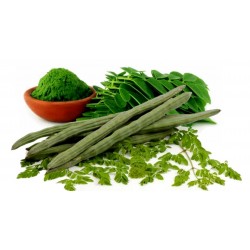
Moringa the Miracle Tree...
Ár
2,65 €
(SKU: T 38)
Seeds Gallery EU,
5/
5
<!DOCTYPE html>
<html>
<head>
<meta http-equiv="Content-Type" content="text/html; charset=UTF-8" />
</head>
<body>
<div id="idTab1" class="rte">
<h2><span style="font-size: 14pt;"><strong>Moringa the Miracle Tree Seeds (Moringa oleifera PKM 1)</strong></span></h2>
<h2><span style="color: #ff0000; font-size: 14pt;"><strong>Price for Package of 5 or 10 seeds.</strong></span></h2>
<p>For those of you who have never heard of Moringa, at all --- we'll just give you a really quick education on it. Moringa Oleifera is the most commonly known variety of Moringa, and it has been grown in many countries, worldwide for thousands of years. Moringa Oleifera, the variety with which most people are familiar, is a slender tree, loaded with long, delicate-looking branches, which are covered with small, oval-shaped dark green leaves. Those lovely leaves are just packed with healthy, and tasty, nutrients. It is basically a tropical tree, but with care, it can be grown just about anywhere. It does NOT like the cold, so in areas where the temperatures get into the 40's, it needs to be kept warm. When the temperatures average in the low 60's, they tend to lose their leaves, and look a bit sickly. When the temperatures rise, they thrive! Ours made it through several winters here in FL, when the temperatures got as low as 28 degrees F, but we kept them sprinkled with water several times a day, and ran Christmas-type lights up, around and between the rows of seedlings.</p>
<p>The Moringa Oleifera tree can reach great heights, left to itself, but that puts its harvest WAY out of reach. Ideally, they should be kept to 6-12 feet, maximum, so you can easily prune the branches,</p>
<p>cut the flowers, and harvest the pods. You can plant the seeds in a row, and maintain the Moringa Oleifera plants as a low hedge, if all you want to do is eat the leaves. They will provide you with abundant greens, as the more you trim them - the faster they seem to grow, the more branches they put out, and the bushier they get. If you do not prune them, the leaves will be hard to reach.</p>
<p>Moringa Oleifera seeds are round and brown with tan "frilled" edges, while the seeds of the Moringa Stenopetala are a light tan, with a shape reminiscent of almonds or pistachios. Click on the bottom box on the right side of the page, to see the differences. It is unusual to see how different the seeds are, for a tree that is still Moringa. The little thumbnail photos above enlarge when you click on them</p>
<p><strong><em>WIKIPEDIA:</em></strong></p>
<p>Moringa oleifera is the most widely cultivated species of the genus Moringa, which is the only genus in the family Moringaceae. English common names include: moringa,[2] drumstick tree[2] (from the appearance of the long, slender, triangular seed-pods), horseradish tree[2] (from the taste of the roots, which resembles horseradish), ben oil tree or benzoil tree[2] (from the oil which is derived from the seeds). It is a fast-growing, drought-resistant tree, native to the southern foothills of the Himalayas in northwestern India, and widely cultivated in tropical and sub-tropical areas where its young seed pods and leaves are used as a vegetable.</p>
<p><strong>Description</strong></p>
<p>Moringa oleifera is a fast growing, evergreen, deciduous tree. It can reach a height of 10–12 m [5] and the trunk can reach a diameter of 45 cm.[6] The bark has a whitish-grey colour and is surrounded by thick cork. Young shoots have purplish or greenish-white hairy bark. The tree has an open crown of drooping, fragile branches and the leaves build up a feathery foliage of tripinnate leaves.</p>
<p>The flowers are fragrant and bisexual, surrounded by five unequal thinly veined yellowish-white petals. The flowers are approximately 1-1.5 cm long and 2 cm broad. They grow on slender hairy stalks in spreading or drooping later flower clusters which have a longitude of 10–25 cm.[5]</p>
<p>Flowering begins within the first six months after planting. In seasonally cool regions, flowering will only occur once a year between April and June. In more constant seasonal temperature and with constant rainfall, flowering can happen twice or even all year-round.</p>
<p>The fruit is a hanging, three-sided brown capsule of 20–45 cm size which holds dark brown, globular seeds with a diameter of approximately 1 cm. The seeds have three whitish papery wings and are dispersed by wind and water.</p>
<p>In cultivation, it is often cut back annually to 1–2 meters and allowed to regrow so the pods and leaves remain within arm's reach.</p>
<p><strong>Cultivation</strong></p>
<p>The moringa tree is grown mainly in semiarid, tropical, and subtropical areas, corresponding in the United States to USDA hardiness zones 9 and 10. It grows best in dry sandy soil and tolerates poor soil, including coastal areas. As with all plants, optimum cultivation depends on producing the right environment for the plant to thrive. Moringa is a sun and heat-loving plant, and thus does not tolerate freeze or frost. Moringa is particularly suitable for dry regions, as it can be grown using rainwater without expensive irrigation techniques.</p>
<p><strong>Production area</strong></p>
<p>As of 2010, cultivation in Hawaii, for commercial distribution in the United States, is in its early stages.</p>
<p>"India is the largest producer of moringa, with an annual production of 1.1 to 1.3 million tonnes of tender fruits from an area of 380 km². Among the states, Andhra Pradesh leads in both area and production (156.65 km²) followed by Karnataka (102.8 km²) and Tamil Nadu (74.08 km²). In other states, it occupies an area of 46.13 km². Tamil Nadu is the pioneering state in·so·much as it has varied genotypes from diversified geographical areas and introductions from Sri Lanka."</p>
<p>Moringa is grown in home gardens and as living fences in Southern India and Thailand, where it is commonly sold in local markets.[11] In the Philippines, it is commonly grown for its leaves which are used in soup. Moringa is also actively cultivated by the World Vegetable Center in Taiwan, a center for vegetable research with a mission to reduce poverty and malnutrition in developing countries through improved production and consumption of vegetables. Tamil Nadu, Southern India has moringa in its folk stories and use in home gardens. In Haiti it is grown as windbreaks and to help reduce soil erosion.</p>
<p><strong>Cultivation practice</strong></p>
<p>Moringa can be grown as an annual or perennial plant. In the first year all pods are edible. Later years also bear non edible bitter pods. Therefore Moringa is often commercially cultivated annually. On less favorable locations the perennial cultivation has big advantages. Erosion is much smaller with perennial cultivation.[13] Perennial cultivation of Moringa is also practiced in agroforestry.</p>
<p><strong>Soil preparations</strong></p>
<p>In tropical cultivation sides the soil erosion is a major problem. Therefore the soil treatment has to be as low as possible. Plowing is required only for high planting densities. In low planting densities "it is better to dig pits and refill them with the soil. This ensures good root system penetration without causing too much land erosion. The pits must be 30 to 50 cm deep, and 20 to 40 cm wide."</p>
<p><strong>Propagation</strong></p>
<p>Moringa can be propagated from seed or cuttings. Direct seeding is possible because the germination rate of Moringa oleifera is high. After 12 days the germination rate is about 85%.[8] Production in seedbeds or containers is very time consuming. In these technics the plants can be better protected from insects and other pests. They are also used in areas where soil erosion is a problem.</p>
<p>Cuttings of 1 meter length and a diameter of at least 4 cm can be also used for propagation.[8] At least one third of the cutting must be buried in the soil. In the Philippines, moringa is propagated by planting 1–2 m-long limbs cuttings, preferably from June to August. It can also be propagated by seeds, which are planted an inch below the surface and can be germinated year-round in well-draining soil.</p>
<p><strong>Planting</strong></p>
<p>For intensive leaf production "the spacing of plants should be 15 x 15 cm or 20 x 10 cm, with conveniently spaced alleys (for example: every 4 meters) to facilitate plantation management and harvests. Another option is to space the seeding lines 45 cm apart and to sow every 5cm on those lines. One can also space the lines only 30 cm apart and sow at a larger distance on the lines (10 to 20 cm)".[8] Weeding and disease prevention are difficult because of the high density.</p>
<p>In a semi-intensive production the plants are spaced 50 cm to 1 m apart. This gives good results with less maintenance.</p>
<p>Moringa trees can also be cultivated in alleys, as natural fences and associated with other crops. The distance between moringa rows in an agroforestry cultivation are usually between 2 to 4 meters.[8]In Haiti it is being used as fencing and windbreaks on farms.</p>
<p><strong>Breeding</strong></p>
<p>In India, from which Moringa most likely originates, the diversity of Moringa in cultivars in wild types is large.[13] This gives a good basis for breeding programs. In countries where Moringa has been introduced as a cultivar, the diversity is usually much smaller among the cultivar types. Locally well adapted wild types on the other hand, can be found in most regions.</p>
<p>Because Moringa is cultivated and used in different ways, exist different breeding aims. The breeding aims for an annual or a perennial plant are obviously different. The yield stability of fruits are an important breeding aim for the commercial cultivation in India where Moringa is cultivated annually. On less favorable locations the perennial cultivation has big advantages. Erosion is much smaller with perennial cultivation.[13] Perennial cultivation of Moringa is also used in agroforestry. In Pakistan varieties have been tested for their nutritional composition of the leaves on different locations.[14] The different breeding aims result in a different selection. India selects for a higher number of pods and dwarf or semi-dwarf varieties. Breeders in Tanzania on the other hand are selecting for a higher oil content.[15] In total, only little breeding has been achieved so far.</p>
<p><strong>Yield and Harvest</strong></p>
<p>Moringa oleifera can be cultivated for its leaves, pods and/or its kernels for oil extraction and water purification. The yields vary widely, depending on season, variety, fertilization, and irrigation regime. Moringa yields best under warm, dry conditions with some supplemental fertilizer and irrigation.[16] Moringa harvest is done manually with knifes, sickles and stabs with hooks attached to it.</p>
<p><strong>Fruits</strong></p>
<p>When the plant is grown up from cuttings the first harvest can already take place after 6-8 month after plantation. Often, the fruits are not yielded in the first year and the yield is generally low during the first years. By year 2 it produces around 300 pods, by year 3 around 400-500. A good tree can yield 1000 or more pods.[17] In India a hectare can produce 31 tons of pods per year.[16] Under North Indian conditions the fruits ripen during the summer. Sometimes, particularly in South India, flowers and fruits appear twice a year and so there are 2 harvests, in July to September and March to April.</p>
<p><strong>Leaves</strong></p>
<p>Average yields of 6 tons/ha/year in fresh matter are can be achieved. The harvest differs strongly between the rainy and dry season with 1120 kg/ha per harvest and 690 kg/ha per harvest. The leaves and stems can be harvested from the young plants 60 days after seeding and then another 7 times in the year. At every harvest the plants are cut back to within 60 cm of the ground.[19] In some production systems the leaves are harvested every 2 weeks. Foidl. et al. (2001) showed that the cultivation of Moringa oleifera can also be done intensively with irrigation and fertilization with suitable varieties. Trials in Nicaragua with 1 million plant/ha and 9 cuttings/year over 4 years gave an average fresh matter production of 580 metric tons per ha/year equivalent to about 174 metric tons of fresh leaves.</p>
<p><strong>Oil</strong></p>
<p>One estimate for yield of oil from kernels is 250 liters per hectare.[16]The oil can be used as a food supplement, as a base for cosmetics and for hair and the skin.</p>
<p><strong>Pests and diseases</strong></p>
<p>The moringa tree is not affected by any serious diseases in its native or introduced ranges.</p>
<p>In India there are several insect pests, including various caterpillars such as the bark-eating caterpillar, the hairy caterpillar or the green leaf caterpillar. The budworms Noctuidae are known to cause serious defoliation. Damaging agents can also be aphids, stem borers and fruity flies. In some regions termites can also cause minor damages. If termites are numerous in soils the insects management costs are not bearable.</p>
<p>The moringa tree is a host to Leveillula taurica, a powdery mildew which causes damage in papaya crops in south India. Cultivation management should therefore be checked.</p>
<p><strong>Leaves</strong></p>
<p>The leaves are the most nutritious part of the plant, being a significant source of B vitamins, vitamin C, provitamin A as beta-carotene, vitamin K, manganese and protein, among other essential nutrients.[22][23] When compared with common foods particularly high in certain nutrients per 100 g fresh weight, cooked moringa leaves are considerable sources of these same nutrients. See chart on the right for nutritional value for fresh leaves. See chart below for nutrional value of dried leaves.</p>
<p>Some of the calcium in moringa leaves is bound as crystals of calcium oxalate[26] though at levels 25-45 times less than that found spinach, which is a negligible amount.</p>
<p>The leaves are cooked and used like spinach. In addition to being used fresh as a substitute for spinach, its leaves are commonly dried and crushed into a powder used in soups and sauces. As with most foods, heating moringa above 140 degrees Fahrenheit destroys some of the nutritional value.</p>
<p><strong>Drumsticks</strong></p>
<p>The immature seed pods, called "drumsticks", are commonly consumed in South Asia. They are prepared by parboiling, and cooked in a curry until soft.[27] The seed pods/fruits, even when cooked by boiling, remain particularly high in vitamin C[28] (which may be degraded variably by cooking) and are also a good source of dietary fiber, potassium, magnesium and manganese.</p>
<p><strong>Seeds</strong></p>
<p>The seeds, sometimes removed from more mature pods and eaten like peas or roasted like nuts, contain high levels of vitamin C and moderate amounts of B vitamins and dietary minerals (right table, USDA).</p>
<p><strong>Seed oil</strong></p>
<p>Mature seeds yield 38–40% edible oil called ben oil from its high concentration of behenic acid. The refined oil is clear and odorless, and resists rancidity. The seed cake remaining after oil extraction may be used as a fertilizer or as a flocculent to purify water.[29] Moringa seed oil also has potential for use as a biofuel.</p>
<p><strong>Roots</strong></p>
<p>The roots are shredded and used as a condiment in the same way as horseradish; however, they contain an alkaloid, potentially having nerve-paralyzing properties.</p>
<p><strong>Malnutrition relief</strong></p>
<p>Moringa trees have been used to combat malnutrition, especially among infants and nursing mothers. Five NGOs in particular — Trees for Life International, The Christian and Missionary Alliance, Church World Service, Educational Concerns for Hunger Organization, and Volunteer Partnerships for West Africa — have advocated moringa as "natural nutrition for the tropics."[25] One author stated that "the nutritional properties of Moringa are now so well known that there seems to be little doubt of the substantial health benefit to be realized by consumption of Moringa leaf powder in situations where starvation is imminent."</p>
<p>Moringa is especially promising as a food source in the tropics because the tree is in full leaf at the end of the dry season when other foods are typically scarce.</p>
<p><strong>Culinary uses</strong></p>
<p>Moringa has numerous applications in cooking throughout its regional distribution. It may be preserved by canning and exported.</p>
<p>In Bangladesh, it is made into a variety of curry dishes by mixing with coconut, poppy seeds, and mustard or boiled until the drumsticks are semisoft and consumed directly without any extra processing or cooking. It is used in curries, sambars, kormas, and dals, although it is also used to add flavor to cutlets and other recipes.</p>
<p>The fruit meat of drum sticks, including young seeds, is used for soup. Young leaves can either be fried with shrimp or added as a topping in fish soup.</p>
<p>There are several traditional Cambodian dishes using leaves (sluc) of the moringa tree known as daum m'rum,[37] such as korko (a mixed vegetable soup). As it is a favorite vegetable, Cambodians traditionally grow moringa trees close to their residences.</p>
<p>In South India, Sri Lanka and Java, it is used to prepare a variety of sambar, is fried, or made into curry dishes by mixing with coconut, poppy seeds, and mustard or boiled until the drumsticks are semisoft and consumed directly without any extra processing or cooking. It is used in curries, sambars, kormas, and dals, although it is also used to add flavors, such as in ghee and soups. In Maharashtra, the pods are used in sweet and sour curries. In Gujarat and Rajasthan, the pods are used in to cook a spicy curry.</p>
<p>Tender drumstick leaves, finely chopped, are used as garnish for vegetable dishes and salads. It is also used in place of or along with coriander. In some regions, the flowers are gathered and cleansed to be cooked with besan to make pakoras.</p>
<p>The leaves may be fried and mixed with dried-fried tuna chips (Maldive fish), onions and dried chillies. This is equivalent to a sambal and eaten along with rice and curry. In one area in the Maldives, a soup is made with these leaves and rice, and eaten especially for breakfast during the month of Ramazan. It is also a common ingredient in an omelet. The pods are used to cook a mild curry.</p>
<p>In the Punjab region of India and Pakistan, moringa called Soanjhna flowers are first separated from the stem, boiled, mashed and cooked. Curdle is an important element of its recipe to create a specific taste and favorite dish.</p>
<p>The green pods, the leaves and the flowers are used in a variety of Thai dishes, such as curries, stir-fries, soups, omelets and salads. One of the most traditional dishes is sour Thai curry made with the drumstick pods and fish.</p>
<p>In the Philippines, moringa leaves, known as kamunggay, malunggay or marungay, are commonly added to broth as a simple soup. The leaves may also be used as a typical ingredient in tinola, a traditional chicken dish consisting of chicken in a broth, moringa leaves, and either green papaya or another vegetable or in the all vegetable dish known as utan. The leaves can also be processed with olive oil and salt for a pesto-like pasta sauce that has become popular on the Filipino culinary scene. Moringa juice may be mixed with lemonsito juice to make ice candies or cold drinks, possibly more palatable to those who dislike vegetables.</p>
<p>In 2007, Filipino Senator Loren Legarda campaigned for the popularization of moringa. She asked the government to make moringa among its priority crops for propagation, citing a Bureau of Plant Industry report about moringa's nutritional content.[38][39] The leaves may also be used in making polvoron (a milky, powdered snack), biofuel, and ben oil.</p>
<p><strong>Other uses</strong></p>
<p>In developing countries, moringa has the potential to improve nutrition, boost food security, foster rural development, and support sustainable landcare.[35] It may be used as forage for livestock, a micronutrient liquid, a natural anthelmintic and possible adjuvant.</p>
<p>Moringa has been used in folk medicine,[36] including Siddha medicine and Ayurvedic traditional medicines and in the Philippines.[43] In Ayurvedic traditional medicine, the leaves are believed to affect blood pressure and glucose levels.[44] In Africa, Indonesia and Philippines, moringa leaves are given to nursing mothers in the belief that they increase lactation.</p>
<p><iframe width="640" height="385" src="https://www.youtube.com/embed/txbXMGnCERU?rel=0&hd=1" frameborder="0" class="embed-responsive-item"> </iframe></p>
</div>
</body>
</html>
T 38 10S


Az Amerikai Egyesült Államokból származó fajta
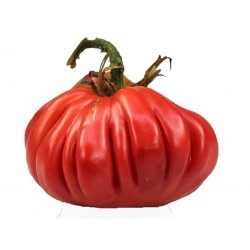
Pink Accordion Tomato Seeds
Ár
1,95 €
(SKU: VT 94)
Seeds Gallery EU,
5/
5
<h2 class=""><strong>Pink Accordion Tomato Seeds</strong></h2>
<h2><span style="color: #ff0000;"><strong>Price for Package of 10 seeds.</strong><strong><span style="font-size: 10pt;"><br></span></strong></span></h2>
<p>A unique show tomato. Our tomato fest organic tomato seeds produce big, sprawling, regular-leaf tomato plants that provide an average yield of beautiful, 1 pound, dark-pink tomatoes that are very fluted or ruffled like an accordion. Tomato lovers consistently rave about this beautiful tomato. A perfect choice for a commercial market tomato because of its popularity. The tomato is slightly hollow making it a good stuffing tomato. Flavors are mild and sweet. A low-acid tomato with few seeds.</p>
<p>Days: 80</p>
<p>Size: Indeterminate.</p>
<p>Color: Pink</p>
<p>Season: Mid-Season</p>
<div><span style="font-size: 10pt;">Type: Open Pollinated</span></div><script src="//cdn.public.n1ed.com/G3OMDFLT/widgets.js"></script>
VT 94 (10 S)






